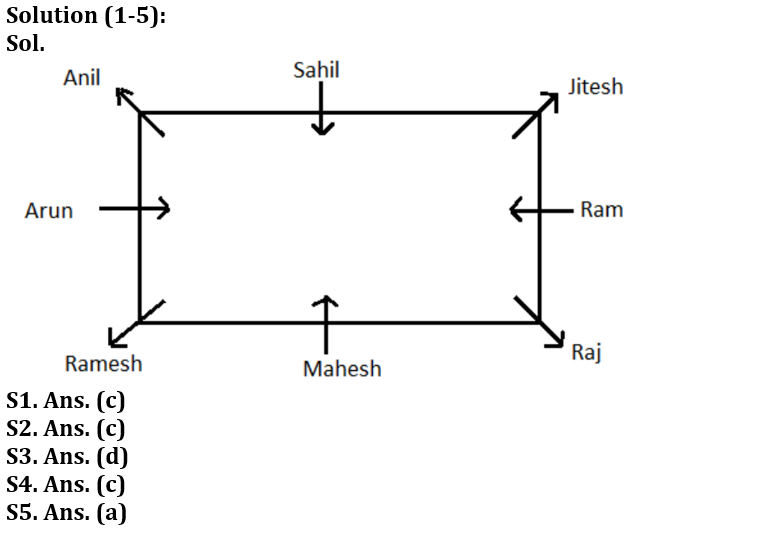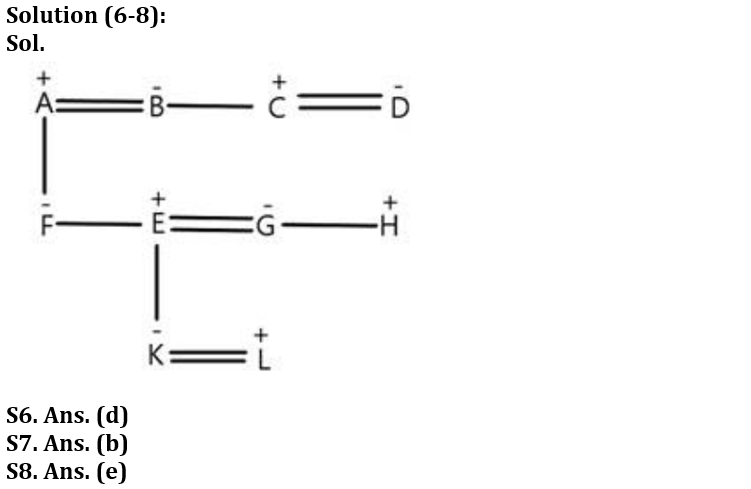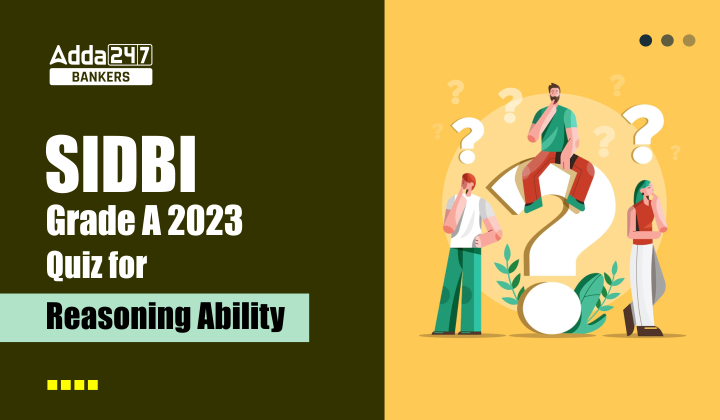Direction (1-5): Read the following information carefully and answer the questions that follow.
Eight persons Ram, Arun, Ramesh, Jitesh, Anil, Raj, Mahesh and Sahil are sitting around a square table in such a way that four of them sit at the corner and four of them sit in the middle of the side of the table. The person sitting at the corners face away from the table and those sitting in the middle face towards the table. Anil and Raj sit diagonally opposite to each other. Ramesh is third to the left of Ram. Mahesh sits opposite to Sahil. Jitesh is 2nd to the left of Raj. Raj is facing away from the table. Arun is third to the left of Jitesh. Mahesh faces towards the table. Ramesh is an immediate neighbour of Mahesh.
Q1. Who sits fifth to the left of Jitesh?
(a) Anil
(b) Ram
(c) Mahesh
(d) Arun
(e) Raj
Q2. Who is fifth to the right of Raj?
(a) Ram
(b) Ramesh
(c) Sahil
(d) Mahesh
(e) None of these
Q3. If the position of Anil and Ram are interchanged, who will now be opposite to Anil?
(a) Raj
(b) Sahil
(c) Ram
(d) Arun
(e) None of these
Q4. Four of the following five are alike in a certain way, find the odd one out.
(a) Jitesh- Raj
(b) Mahesh- Ram
(c) Anil- Ramesh
(d) Sahil- Arun
(e) Raj- Ramesh
Q5. Who sits second to the left of Ramesh?
(a) Raj
(b) Anil
(c) Jitesh
(d) Ram
(e) Sahil
Direction (6-8): Study the following information carefully and answer the questions that follow.
K is the only daughter of E who is the husband of G. A is the husband of B. C is the maternal uncle of E. H is the brother of G. F is the sister of E and daughter of B. L is the son in law G. D is the wife of C. H is the brother-in-law of E.
Q6. How many married couples are there?
(a) One
(b) Two
(c) Three
(d) Four
(e) Five
Q7. How is E related to C?
(a) Niece
(b) Nephew
(c) Son
(d) Daughter
(e) Cannot be determined
Q8. How many females are there?
(a) One
(b) Two
(c) Three
(d) Four
(e) Five
Direction (9-10): Study the following information carefully and answer the questions that follow.
In a family of three generations and eight members, K is married to T who is the only son of S. M is married to P who is the mother of Q. U who is the sister-in-law of T, is married. T has no sibling. H is the only son of Q. S is a male person.
Q9. How many people are there in the third generation?
(a) 2
(b) 3
(c) 1
(d) More than 3
(e) None of these
Q10. What is the ratio of the number of females to that of male members in the family?
(a) 5:3
(b) 1:4
(c) 1:1
(d) 3:5
(e) None of these
Direction (11-15): In each of the following questions, assuming the given statements to be true, find which of the following options holds true:
Q11. Statements: F ≥ H, A ≤ C, G ≥ H, H > C
Conclusions: I. G > H
II. G > C
(a) If only conclusion I is true.
(b) If only conclusion II is true.
(c) If either conclusion I or conclusion II is true.
(d) If neither conclusion I nor conclusion II is true
(e) If both conclusions I and II are true.
Q12. Statements: J ≤ K, S > D < T, E ≥ S, E = G
Conclusions: I. D < E
II. S < G
(a) If only conclusion I is true.
(b) If only conclusion II is true.
(c) If either conclusion I or conclusion II is true.
(d) If neither conclusion I nor conclusion II is true
(e) If both conclusions I and II are true.
Q13. Statements: T ≥ M, M < K, C = K, P < M
Conclusions: I. P < C
II. P < T
(a) If only conclusion I is true.
(b) If only conclusion II is true.
(c) If either conclusion I or conclusion II is true.
(d) If neither conclusion I nor conclusion II is true
(e) If both conclusions I and II are true.
Q14. Statements: R > S < O ≥ C, S = V > D ≥ A
Conclusions: I. R < D
II. O = V
(a) If only conclusion I is true.
(b) If only conclusion II is true.
(c) If either conclusion I or conclusion II is true.
(d) If neither conclusion I nor conclusion II is true
(e) If both conclusions I and II are true.
Q15. Statements: D < E ≥ C = V > G ≤ T, C ≥ O
Conclusions: I. O ≤ E
II. D > O
(a) If only conclusion I is true.
(b) If only conclusion II is true.
(c) If either conclusion I or conclusion II is true.
(d) If neither conclusion I nor conclusion II is true
(e) If both conclusions I and II are true.
Solutions



Solution (11-15):
S11. Ans. (b)
Sol. I. G > H – False
II. G > C – True.
S12. Ans. (a)
Sol. I. D < E – True
II. S < G – False
S13. Ans. (e)
Sol. I. P < C – True
II. P < T – True
S14. Ans. (d)
Sol. I. R < D – False
II. O = V – False
S15. Ans. (a)
Sol. I. O ≤ E – True
II. D > O – False





 GA Capsule for SBI Clerk Mains 2025, Dow...
GA Capsule for SBI Clerk Mains 2025, Dow...
 The Hindu Review October 2022: Download ...
The Hindu Review October 2022: Download ...
 ECGC PO Cut off 2025 Out, Check Final Cu...
ECGC PO Cut off 2025 Out, Check Final Cu...




